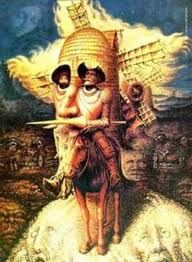This is your morning Open Thread. Pour your favorite beverage and review the past and comment on the future.
Find the past “On This Day in History” here.
October 3 is the 276th day of the year (277th in leap years) in the Gregorian calendar. There are 89 days remaining until the end of the year.
On this day in 1967, Woody Guthrie, godfather of the 1950s folk revival movement, dies.
In 1963, Bob Dylan was asked by the authors of a forthcoming book on Woody Guthrie to contribute a 25-word comment summarizing his thoughts on the man who had probably been his greatest formative influence. Dylan responded instead with a 194-line poem called “Thoughts on Woody Guthrie,” which took as its theme the eternal human search for hope. “And where do you look for this hope that yer seekin’?” Dylan asks in the poem, before proceeding to a kind of answer:
You can either go to the church of your choice
Or you can go to Brooklyn State Hospital
You’ll find God in the church of your choice
You’ll find Woody Guthrie in Brooklyn State Hospital
Woodrow Wilson “Woody” Guthrie (July 14, 1912 – October 3, 1967) is best known as an American singer-songwriter and folk musician, whose musical legacy includes hundreds of political, traditional and children’s songs, ballads and improvised works. He frequently performed with the slogan This Machine Kills Fascists displayed on his guitar. His best-known song is “This Land Is Your Land”, which is regularly sung in American schools. Many of his recorded songs are archived in the Library of Congress. Such songwriters as Bob Dylan, Phil Ochs and Tom Paxton have acknowledged their debt to Guthrie as an influence.
Guthrie traveled with migrant workers from Oklahoma to California and learned traditional folk and blues songs. Many of his songs are about his experiences in the Dust Bowl era during the Great Depression, earning him the nickname the “Dust Bowl Troubadour”. Throughout his life Guthrie was associated with United States communist groups, though he was never an actual member of any.
Guthrie was married three times and fathered eight children, including American folk musician Arlo Guthrie. He is the grandfather of musician Sarah Lee Guthrie. Guthrie died from complications of Huntington’s disease, a progressive genetic neurological disorder. During his later years, in spite of his illness, Guthrie served as a figurehead in the folk movement, providing inspiration to a generation of new folk musicians, including mentor relationships with Ramblin’ Jack Elliott and Bob Dylan.
Folk revival and Guthrie’s death
In the late 1950s and early 1960s, a new generation of young people were inspired by folk singers including Guthrie. These “folk revivalists” became more politically aware in their music than those of the previous generation. The American Folk Revival was beginning to take place, focused on the issues of the day, such as the civil rights movement and free speech movement. Pockets of folk singers were forming around the country in places such as Cambridge, Massachusetts and the Greenwich Village neighborhood of New York City. One of Guthrie’s visitors at Greystone Park was the 19-year-old Bob Dylan, who idolized Guthrie. Dylan wrote of Guthrie’s repertoire: “The songs themselves were really beyond category. They had the infinite sweep of humanity in them.” After learning of Guthrie’s whereabouts, Bob Dylan regularly visited him. Guthrie died of complications of Huntington’s disease on October 3, 1967. By the time of his death, his work had been discovered by a new audience, introduced to them in part through Bob Dylan, Pete Seeger, Ramblin’ Jack Elliott, his ex-wife Marjorie and other new members of the folk revival, and his son Arlo.
Huntington’s Disease Society of America

 The Twilight Zone is an American anthology television series created by
The Twilight Zone is an American anthology television series created by 


 Thomas Young was one of the first to attempt decipherment of the Egyptian hieroglyphs, basing his own work on the investigations of Swedish diplomat Akerblad, who built up a demotic alphabet of 29 letters (15 turned out to be correct) and translated all personal names and other words in the Demotic part of the Rosetta Stone in 1802. Akerblad however, wrongly believed that demotic was entirely phonetic or alphabetic. Young thought the same, and by 1814 he had completely translated the enchorial (which Champollion labeled Demotic as it is called today) text of the Rosetta Stone (he had a list with 86 demotic words). Young then studied the hieroglyphic alphabet and made some progress but failed to recognise that demotic and hieroglyphic texts were paraphrases and not simple translations. In 1823 he published an Account of the Recent Discoveries in Hieroglyphic Literature and Egyptian Antiquities. Some of Young’s conclusions appeared in the famous article Egypt he wrote for the 1818 edition of the Encyclopædia Britannica.
Thomas Young was one of the first to attempt decipherment of the Egyptian hieroglyphs, basing his own work on the investigations of Swedish diplomat Akerblad, who built up a demotic alphabet of 29 letters (15 turned out to be correct) and translated all personal names and other words in the Demotic part of the Rosetta Stone in 1802. Akerblad however, wrongly believed that demotic was entirely phonetic or alphabetic. Young thought the same, and by 1814 he had completely translated the enchorial (which Champollion labeled Demotic as it is called today) text of the Rosetta Stone (he had a list with 86 demotic words). Young then studied the hieroglyphic alphabet and made some progress but failed to recognise that demotic and hieroglyphic texts were paraphrases and not simple translations. In 1823 he published an Account of the Recent Discoveries in Hieroglyphic Literature and Egyptian Antiquities. Some of Young’s conclusions appeared in the famous article Egypt he wrote for the 1818 edition of the Encyclopædia Britannica. The first Congress of the United States approves 12 amendments to the U.S. Constitution, and sends them to the states for ratification. The amendments, known as the Bill of Rights, were designed to protect the basic rights of U.S. citizens, guaranteeing the freedom of speech, press, assembly, and exercise of religion; the right to fair legal procedure and to bear arms; and that powers not delegated to the federal government were reserved for the states and the people.
The first Congress of the United States approves 12 amendments to the U.S. Constitution, and sends them to the states for ratification. The amendments, known as the Bill of Rights, were designed to protect the basic rights of U.S. citizens, guaranteeing the freedom of speech, press, assembly, and exercise of religion; the right to fair legal procedure and to bear arms; and that powers not delegated to the federal government were reserved for the states and the people.
Recent Comments